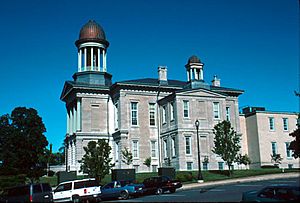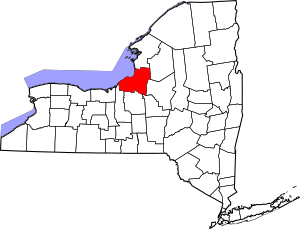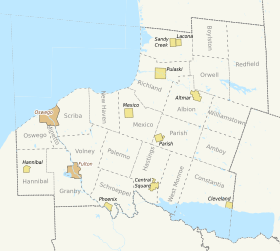Oswego County, New York facts for kids
Quick facts for kids
Oswego County
|
|||
|---|---|---|---|

Oswego County Courthouse
|
|||
|
|||

Location within the U.S. state of New York
|
|||
 New York's location within the U.S. |
|||
| Country | |||
| State | |||
| Founded | 1816 | ||
| Seat | Oswego | ||
| Largest city | Oswego | ||
| Area | |||
| • Total | 1,312 sq mi (3,400 km2) | ||
| • Land | 952 sq mi (2,470 km2) | ||
| • Water | 360 sq mi (900 km2) 27% | ||
| Population
(2020)
|
|||
| • Total | 117,525 | ||
| • Density | 123.5/sq mi (47.7/km2) | ||
| Time zone | UTC−5 (Eastern) | ||
| • Summer (DST) | UTC−4 (EDT) | ||
| Congressional districts | 22nd, 24th | ||
Oswego County is a special area called a county in the state of New York. In 2020, about 117,525 people lived here. The main town, or county seat, is Oswego.
The name "Oswego" comes from a Mohawk word. It means "the pouring out place." This refers to where the Oswego River flows into Lake Ontario. Oswego County is part of the Central New York area. It is also part of the larger Syracuse Metropolitan Statistical Area.
Contents
History of Oswego County
How Oswego County Was Formed
When New York was a British colony in 1683, the land that is now Oswego County was part of Albany County. This was a huge area. It included much of what is now New York state and even parts of Vermont.
Over time, this large county was split into smaller ones. In 1772, Albany County was divided into three parts. One new part was called Tryon County. This county covered a vast western area. It was named after William Tryon, who was the colonial governor.
After the American Revolutionary War ended in 1784, the name of Tryon County changed. It became Montgomery County. This was to honor General Richard Montgomery, a hero of the war.
More counties were created from Montgomery County. In 1789, Ontario County was formed. Then, in 1791, Herkimer County was created. Later, in 1794, Onondaga County was made from part of Herkimer County. In 1798, Oneida County was also created from Herkimer County.
Finally, in 1816, Oswego County was officially created. It was formed from parts of Oneida and Onondaga counties. It became the 48th county in New York State.
Past Attempts to Change the County
In 1841, some business people in Oswego wanted to split the county into two. They wanted an "East" and "West" part. The eastern part would even be called "Salmon County." But their plan did not happen. Sometimes, people still talk about this idea today.
For many years, people also tried to move the county seat. They wanted to move it from Oswego to the Village of Mexico. These attempts happened from 1847 all the way up to 1975. However, none of them were successful.
Recent Events in Oswego County
On April 20, 2002, an earthquake shook Oswego County. It happened early in the morning. The earthquake was a magnitude 5.2. It was centered near Plattsburgh, New York. Only minor damage was reported, and no one was hurt.
In February 2007, Oswego County had a huge snowstorm. Over 10 feet of snow fell in some areas. This caused roofs to collapse and some towns to be cut off. Many people were snowed into their homes. The governor declared a state of emergency. The National Guard came to help clear the snow.
Geography of Oswego County
Oswego County is in the northwestern part of New York State. It is just north of Syracuse. The county sits on the eastern shore of Lake Ontario.
The county covers about 1,312 square miles. About 952 square miles are land. The remaining 360 square miles, or 27%, are water.
Natural Features
Part of the Tug Hill Plateau is in the eastern part of the county. This is the highest point, reaching about 1,550 feet. The Salmon River Falls is a beautiful 110-foot waterfall. It is a popular place to visit in the northeastern part of the county.
Oswego County has two important harbors. One is Oswego Harbor, where the Oswego River meets Lake Ontario. The other is Port Ontario on the Salmon River. The Port of Oswego Authority dock is the first major port on the Great Lakes.
Neighboring Counties
Oswego County shares borders with these other counties:
- Jefferson County – to the north
- Lewis County – to the northeast
- Oneida County – to the east
- Madison County – to the southeast
- Onondaga County – to the south
- Cayuga County – to the southwest
Main Roads
Many important roads run through Oswego County:
Population and People (Demographics)
| Historical population | |||
|---|---|---|---|
| Census | Pop. | %± | |
| 1820 | 12,374 | — | |
| 1830 | 27,119 | 119.2% | |
| 1840 | 43,619 | 60.8% | |
| 1850 | 62,198 | 42.6% | |
| 1860 | 75,958 | 22.1% | |
| 1870 | 77,941 | 2.6% | |
| 1880 | 77,911 | 0.0% | |
| 1890 | 71,883 | −7.7% | |
| 1900 | 70,881 | −1.4% | |
| 1910 | 71,664 | 1.1% | |
| 1920 | 71,045 | −0.9% | |
| 1930 | 69,645 | −2.0% | |
| 1940 | 71,275 | 2.3% | |
| 1950 | 77,181 | 8.3% | |
| 1960 | 86,118 | 11.6% | |
| 1970 | 100,897 | 17.2% | |
| 1980 | 113,901 | 12.9% | |
| 1990 | 121,771 | 6.9% | |
| 2000 | 122,377 | 0.5% | |
| 2010 | 122,109 | −0.2% | |
| 2020 | 117,525 | −3.8% | |
| U.S. Decennial Census 1790–1960 1900–1990 1990–2000 2010–2019 |
|||
In 2000, there were 122,377 people living in Oswego County. There were about 45,522 households. Many families lived together, with 52.8% being married couples. About 35% of households had children under 18.
The average age of people in the county was 35 years old. About 26.8% of the population was under 18. About 11.3% were 65 years or older.
Most people in Oswego County (97.17%) were White in 2000. About 1.30% of the population was Hispanic or Latino. Most people spoke English at home.
2020 Census Information
Here is a look at the different groups of people living in Oswego County in 2020:
| Race | Num. | Perc. |
|---|---|---|
| White (NH) | 105,710 | 90% |
| Black or African American (NH) | 1,370 | 1.7% |
| Native American (NH) | 457 | 0.4% |
| Asian (NH) | 870 | 0.7% |
| Pacific Islander (NH) | 19 | 0.01% |
| Other/mixed (NH) | 5,483 | 4.7% |
| Hispanic or Latino | 3,616 | 3.1% |
Colleges in Oswego County
Oswego County is home to two colleges:
- State University of New York at Oswego in the Town of Oswego.
- The Fulton Branch Campus of Cayuga County Community College in the City of Fulton.
Communities in Oswego County
Oswego County has 22 towns, 2 cities, and 10 villages.
Largest Towns and Cities
Here are some of the larger places where people live in Oswego County:
| # | Location | Population | Type | Area |
|---|---|---|---|---|
| 1 | †Oswego | 18,142 | City | Lake Shore |
| 2 | Fulton | 11,896 | City | Riverbank |
| 3 | ‡Brewerton | 4,029 | CDP | Lake Oneida |
| 4 | Phoenix | 2,382 | Village | Riverbank |
| 5 | Pulaski | 2,365 | Village | Lake Shore |
| 6 | Central Square | 1,848 | Village | Lake Oneida |
| 7 | Mexico | 1,624 | Village | Lake Shore |
| 8 | Constantia | 1,182 | CDP | Lake Oneida |
| 9 | Minetto | 1,069 | CDP | Riverbank |
| 10 | Sand Ridge | 849 | CDP | Riverbank |
| 11 | Sandy Creek | 771 | CDP | Lake Shore |
| 12 | Cleveland | 750 | Village | Lake Oneida |
| 13 | Lacona | 582 | Village | Lake Shore |
| 14 | Hannibal | 555 | Village | Riverbank |
| 15 | Parish | 450 | Village | East |
| 16 | ††Altmar | 407 | CDP | East |
† - County seat
†† - Former village
‡ - Not wholly in this county
Towns in Oswego County
Nature and Outdoor Fun
The Lake Ontario National Marine Sanctuary is in the waters of southeastern Lake Ontario. It is located off the coast of Oswego County.
There are many places to go swimming in the county:
- On Lake Ontario
- Selkirk Shores State Park
- Sandy Island Beach State Park
- Mexico Point State Park
- Salmon River Lighthouse and Marina (near Selkirk Light)
- On Oneida Lake
- Taft Bay Park at Bernhards Bay, New York. There are other swimming spots on Oneida Lake too. Oswego County includes most of the northern shore of the lake. It also includes all of the lake's surface from the north shore to the south shore.
- Pool Swimming
- Brennan Beach RV Resort
- Gallager Pool in Oswego
- Scriba Town Park
- Fulton City Pools
Economy
Oswego County's economy is mostly based on industry. In 2012, manufactured goods were worth $2.1 billion. Retail sales were also important, totaling $1.2 billion. This means more than $10,000 for every person living there. Wholesale businesses also made $368 million in sales that year. Services like food, healthcare, and lodging added over $500 million to the economy.
Media
The Sample News Group publishes four newspapers in Oswego County. These include The Palladium-Times, Valley News, Oswego County News, and Oswego Shopper. They also run the website OswegoCountyNewsNow.com.
Education
Here are the school districts in Oswego County:
- Altmar-Parish-Williamstown Central School District
- Camden Central School District
- Cato-Meridian Central School District
- Central Square Central School District
- Fulton City School District
- Hannibal Central School District
- Mexico Central School District
- Oswego City School District
- Phoenix Central School District
- Pulaski Central School District
- Sandy Creek Central School District
- South Jefferson Central School District
See also
 In Spanish: Condado de Oswego para niños
In Spanish: Condado de Oswego para niños




